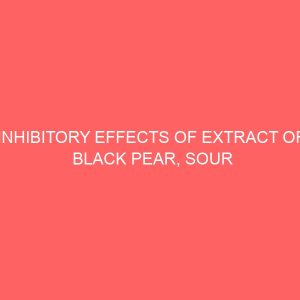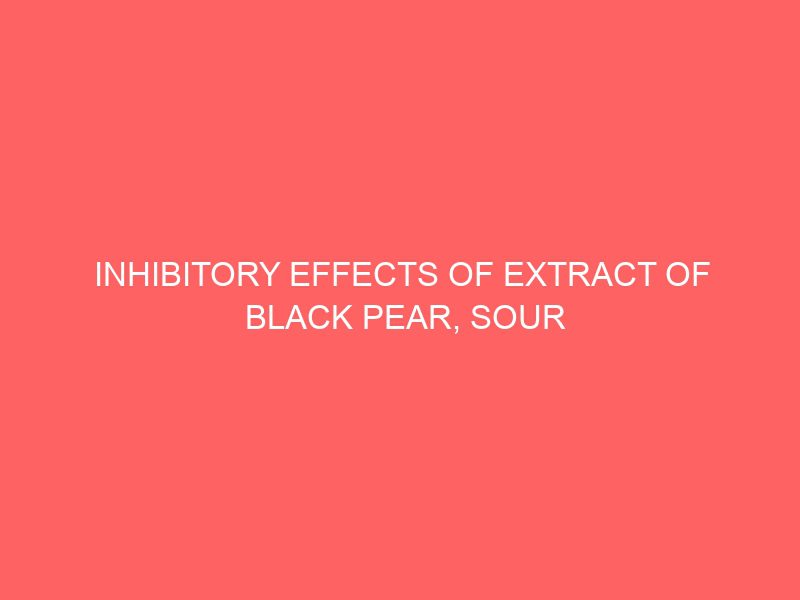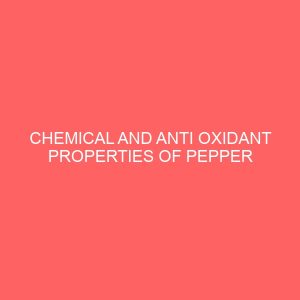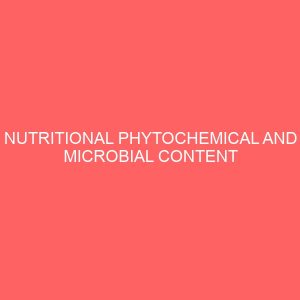Description
CHAPTER ONE
INTRODUCTION
Reactive oxygen species ROS and reactive nitrogen species RON are free radicals, which derived either from normal metabolic processes or from external sources Magalhaes, 2006. These species are essential to energy supply, detoxification, chemical signalling and immune function Dimitrios, 2006. However, overproduction of these free radical may lead to damage to valuable biomolecules such as DNA, lipids and proteins.
These free radicals are often associated with the oxidation in food and biological systems which will cause oxidative rancidity in foods and the development of several human diseases such as neurological degeneration, diabetes and certain types of cancer Magalhaes, 2006.
An antioxidant is any substance which is capable of delaying, preventing the oxidative damage of lipids, protein and nucleic acids by reactive oxygen species, which include reactive free radicals such as superoxide, hydroxyl, peroxyl, alkoxyl and nonradicals such as hydrogen peroxide and hypochlorous Lim et al., 2007.
Thus, antioxidants have gained numerous attention in the past few years, especially within the food, biological and agrochemical fields. There is increasing evidence that the consumption of vegetables and fruits is associated with a reduced risk of degenerative disease such as cancer, cardiovascular disease and cataracts Chinnici et al., 2004. This association is often attributed to the natural antioxidant present in fruits and vegetables, such as vitamin C and E, carotenoids, phenolic acids and flavonoids, which prevent free radical damage Silva et al., 2004.
Epidemiological studies have established a positive correlation between the intake of fruits and vegetables and prevention of diseases like atherosclerosis, cancer, diabetes, arthritis and also ageing Kaur and Kapoor, 2001.
Annona muricata L. A. muricata is one of the tropical fruits that demonstrate antioxidant properties. This plant contains annonaceous acetogenins in the twigs, unripe fruit, seeds, roots, and bark tissues, which display antitumor, pesticidal, antimalarial, anthelmintic, piscicidal, antiviral, and antimicrobial effects, thus suggesting many potentially useful applications. Ripe A. muricata pulp extract contains three prominent acetogenins: asimicin, bullatacin, and bullatalicin.
Previous research on A. muricata was focused on the leaves, seeds and roots for pharmaceutical purposes Gleeve et al., 1997; Jaramillo et al., 2000; Onimawo, 2002. Little attention has been paid to the study of the pulp and peel of A. muricata fruit. This study was therefore conducted to compare the antioxidant properties, phytoconstituents, proximate and mineral compositions of the peel and pulp of A. muricata.
Persea americana Mill Luraceae is one of the 150 varieties of avocado pear. The tree is widely cultivated in tropical and subtropical areas Lu et al., 2005. The seed of P. americana avocado seed has diverse application in ethnomedicine, ranging from treatment for diarrhea, dysentery, toothache, intestinal parasites, skin treatment and beautification.
The avocado seed oil has several health benefit e.g. for controlling human weight especially used for obese for weight loss Lopez et al., 1996; Roger, 1999. P. americana leaves have been reported to have or possess antiinflammatory and analgesic activities Adeyemi et al., 2002. The edible part fruit is very popular in vegetarian cuisine, making a substitute for meat in sandwiches and salads, because of its high fat content and high in valuable, healthpromoting fats Lu et al., 2005 . The fruit is not sweet but fatty, almost distinctly, yet subtly flavoured, and of smooth, almost creamy texture. Avocado fruits in many countries such as Mexico, Brazil, South Africa and India are frequently used for milkshakes and occasionally added to icecream Zeldes, 2010.
While several works had been reported on the chemical characterization of phytoconstituents of P. americana fruit, there is still limited information on its potential use in the management/prevention of degenerative diseases associated with oxidative stress. Hence, the objective of this study is to investigate the antioxidative properties and inhibitory effect of phenolic extracts of the leaves and fruit parts of P. americana on Fe2 induced lipid oxidation.
The plant Cola lepidota, also known as monkey cola in West Cameroons, Duala, mbwid; oji ochicha cockroach cola or achicha Iwu, 1993 amongst the Ibo speaking people of Nigeria, belongs to the sterculiaceae family. It grows wild and sometimes cultivated in the tropics especially distributed in lower Guinea, Gabon, Western Cameroon and Eastern Nigeria. The phytoconstituents found in the seed of Cola lepidota include falvones; glycosides, saponins, steroids Burkill, 1985. The seed has been used as febrifuges, for pulmonary disorders, and as an anticancer Engel et al., 2011. Until now, there has not been a report on the antioxidant activity of any part of Cola lepidota. As part of an ongoing biological evaluation of medicinal plants for their therapeutic uses, the current study was carried out to determine the free radical scavenging activity viz avis the antioxidant activity.
BACKGROUND OF THE STUDY:
Oxidation of biological molecules has been postulated to induce a variety of pathological events such as diabetes, pancreatitis and ageing Finkel and Holbrook, 2000.
Evidence has shown that these damaging events are caused by free radicals Halliwell and Gutteridge, 1993. Free radicals are unstable species because they have unpaired electron pairing with biological macromolecules. It is well established that free radicals are associated with process that leads to cell degeneration, especially in organs such as brain and pancreas Shulman et al., 2004.
Unchecked activities of ROS had been linked to health disorders such as diabetes mellitus, hypertension, cancer, neurodegenerative diseases, gastric ulcers, reperfusion, arthritis and inflammatory diseases Halliwell, 1989; Vajragupta et al., 2000. In the pancreas, Fe accumulates in acinar cells and in the islets of Langerhans, thereby resulting in the destruction of cells associated with diabetes mellitus Shah and Fonseca, 2011. High levels of both Cu and Fe, with low levels of Zn and Mn play a crucial role in the progression of several degenerative diseases Johnson, 2001.
Although Fe is necessary physiologically as components of many enzymes and proteins, free Fe in the cytosol and mitochondria could cause considerable oxidative damage by acting catalytically in the production of ROS which have the potential to damage cellular lipids, nucleic acids, proteins and carbohydrate resulting in wideranging impairment in cellular function and integrity Britton et al., 2002.
ROS can directly attack the polyunsaturated fatty acids of the cell membranes and induce lipid peroxidation. Malondialdehyde MDA is the end product of lipid peroxidation, which is a process where reactive oxygen species ROS degrade polyunsaturated fatty acids. This compound is a reactive aldehyde and is one of the many reactive electrophile species that cause toxic stress in cells and form advanced glycation endproducts. The production of this aldehyde is used as a biomarker to measure the level of oxidative stress in an organism Murray et al., 2000. However, the most likely and practical way to fight degenerative diseases is to improve body antioxidant status, which could be achieved by higher consumption of fruits and vegetables. Foods of plant origin usually contain natural antioxidants such as phenolic compounds that can scavenge free radicals Sun et al., 2002; Alia et al., 2003; Oboh and Akindahunsi, 2004; Oboh, 2005. Medicinal plant have continued to attract attention in the global search for effective methods of using plants parts e.g. seeds, stems, leaves, roots and bark etc for the treatment of many diseases affecting humans Sofowora, 1993. Many important drugs used in medicine today are directly or indirectly derived from plants due to its bioactive constituents such as; alkaloids, steroids, tannins e.t.c Cordeiro and Oniyangi, 1998.
In recent years, secondary plant metabolites previously with unknown pharmacological activities have been extensively investigated as sources of medicinal agents Krishnaraju et al., 2005. Phenolic compounds are an important group of secondary metabolites, which are synthesized by plants because of plant adaptation to biotic and a biotic stress condition such as infection, water stress, and cold stress Oboh and Rocha 2007.
In recent years, phenolic compounds have attracted the interest of researchers because of their antioxidants capacity; they can protect the human body from free radicals, whose formation is associated with the normal natural metabolism of aerobic cells. The antiradical activity of flavonoids and phenols is principally based on the structural relationship between different parts of their chemical structure RiceEvans et al., 1996.
STATEMENT OF PROBLEM:
Reactive oxygen species ROS and reactive nitrogen species RON are free radicals, which derived either from normal metabolic processes or from external sources Magalhaes, 2006. These species are essential to energy supply, detoxification, chemical signalling and immune function Dimitrios, 2006. However, over production of these free radical may lead to damage to valuable biomolecules such as DNA, lipids and proteins. These free radicals are often associated with the oxidation in food and biological systems which will cause oxidative rancidity in foods and the development of several human diseases such as neurological degeneration, diabetes and certain types of cancer. Discovery of this problem initiated the research of this project topic by the researcher.
OBJECTIVE OF THE STUDY:
The following forms the objective of this study;
Identifications of the free radical that results from either normal metabolic process or from external source affect human health adversely
To assist in creating awareness over the dangers associated with excessive production of these free radicals.
Prove practically how these medical effects can be suppressed in the laboratory.
SIGNIFICANCE OF THE STUDY:
It is the belief of the writer that at the end of this research, the researcher will has been able to portrait the disadvantages of over production of free radicals which have been proved to cause oxidative rancidity in foods and the development of several human diseases such as neurological degeneration, diabetes and certain types of cancer.
SCOPE OF THE STUDY:
The research work only covers the inhibitory effect of black pear, sour sop and monkey seed during lipid oxidation. The practical work was carried out using the fruit part of the fruits to ascertain whether the extracts of the fruits can be suppressed as to avert the adverse human effect.
LIMITATION OF THE STUDY:
The researcher encountered several difficulties during the time of carrying out this research work. The limitation ranges from time constraints which the researcher faced in trying to combine carrying out the research work and preparing for exams. Accessing relevant documents on road construction delay documentation wasnt easy as no company was willing to showcase their flaws. Financing the research was another problem since the research is still a student.








Reviews
There are no reviews yet.